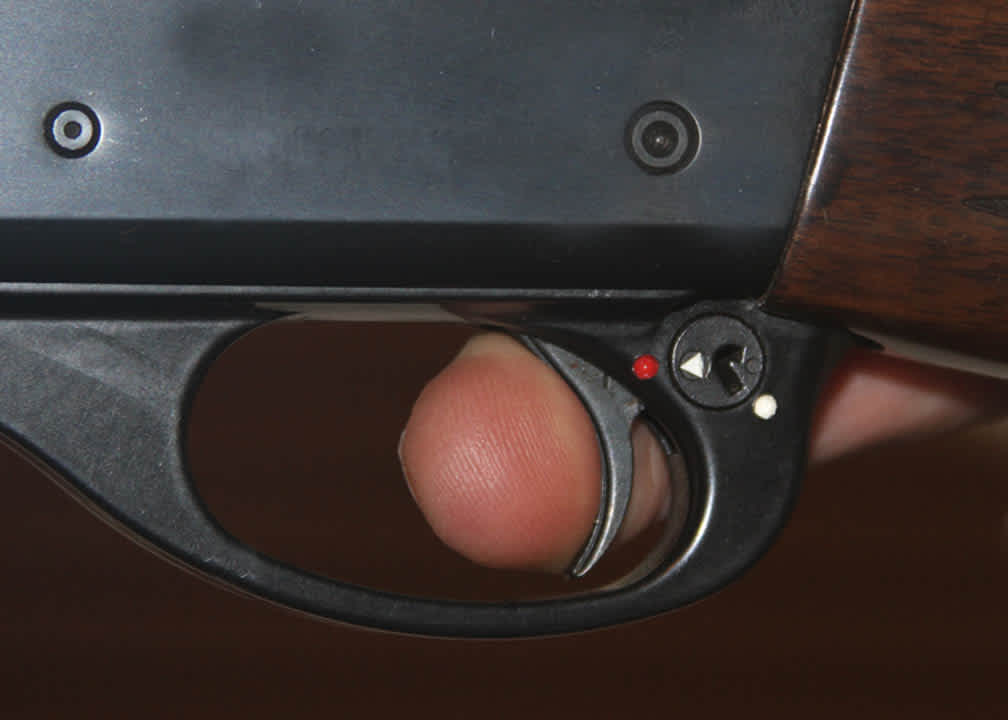Trigger Control for Shotgunners: Don’t Think about It!
Bill Miller 12.22.14

I take some heat from readers and colleagues because I still call what I do to make a shotgun fire “pulling” the trigger. They’ve informed me that the correct word, these days, is to “press” the trigger rather than “squeeze” or “pull” it, especially when it comes to handguns and rifles.
Granted, “press” is probably is the more precise choice because it can describe the motion of a single finger while “squeeze” is more commonly associated with whole-hand movement like “squeezing” an orange. And you definitely don’t want to move your entire hand when you’re aiming a pistol or rifle.
 In part, that’s why I love shotgunning most. We don’t have to be so danged fussy about things. Any time we are pointing a shotgun (as in wingshooting) rather than aiming it (as in slug hunting, turkey hunting, personal defense, and some 3-gun shooting) we can just “pull,” “jerk,” or “slap” the trigger like we’ve always done.
In part, that’s why I love shotgunning most. We don’t have to be so danged fussy about things. Any time we are pointing a shotgun (as in wingshooting) rather than aiming it (as in slug hunting, turkey hunting, personal defense, and some 3-gun shooting) we can just “pull,” “jerk,” or “slap” the trigger like we’ve always done.
In precision long-range shooting, trigger pull-weights are measured in ounces. The best shooters are able to stop and restart pulling the trigger even at pull weights of well under a pound. More than 99 percent of wingshooting shotgunners figure a trigger pull of four pounds is light and most of our triggers pull north of five pounds. Long as it doesn’t have a mile of creep, pass the ammo and let’s go shoot some stuff!
You may have started into this post figuring I was going to unearth some new revelation on the importance of precision triggers in shotguns. Sorry.
My own view has been distorted by the blessing/curse of being a gun writer for 30-plus years now. “On assignment” we almost never get to shoot our own guns. You show up at a press event or hunt, somebody puts a gun in your hands, and you better be able to shoot it. You learn to quickly adapt your shooting technique to the gun.
 In shotgunning, this has reinforced my belief that the greatest detriment to shooting a good score or achieving a laudable shell-to-limit ratio is thinking too much. If a shotgun’s trigger is so heavy or so creepy (or so light, for that matter) that it draws your attention to it as you shoot, you’re going to miss—guaranteed. The optimal trigger in a shotgun for wingshooting is one that’s so vanilla, so middle-of-the-road, so ordinary that you never think twice about it.
In shotgunning, this has reinforced my belief that the greatest detriment to shooting a good score or achieving a laudable shell-to-limit ratio is thinking too much. If a shotgun’s trigger is so heavy or so creepy (or so light, for that matter) that it draws your attention to it as you shoot, you’re going to miss—guaranteed. The optimal trigger in a shotgun for wingshooting is one that’s so vanilla, so middle-of-the-road, so ordinary that you never think twice about it.
As this column has covered previously, drills for wingshooting are much more about consistency and smoothness in mounting the gun than about precision trigger control. While dry-firing drills are important, the purpose for the wingshooting shotgunner is to promote continued swing and follow-through during the trigger pull. Think rubbing your belly and patting your head at the same time.
Another more important drill somewhat related to trigger pull is really an anti-flinch drill. Go to the line at your favorite clay target range with a partner. Let him or her load your gun for you while you look away. About 75 to 80 percent of the time, the partner should load the gun as normal, but the other 20 to 25 percent, they should drop a snap cap into the chamber. Repeating this drill will both reveal any developing flinch problems and help you smooth things out if you do.
The best advice on your wingshooting shotgun’s trigger? If you have one you like—just don’t think about it!
 Tip of the Week
Tip of the Week
Want to pull a trigger that ensures a smash hit every time? That’s the kind of trigger that’s on every ThermaCELL mosquito repellent unit. Use that trigger to ignite the tiny butane flame inside which in turn heats the repellent pad to emit the natural repellent. It’s a guaranteed sure hit with your patio guests, hunting partners, or camp mates!
These insights brought to you by Federal Premium Ammunition, ThermaCELL, Camp Chef, and the Quebec Outfitters Federation.



